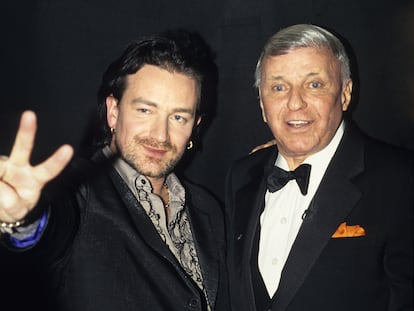Frank Sinatra’s final triumph
‘L. A. Is My Lady’ was released 40 years ago, an album that reunited the singer with a former collaborator, Quincy Jones. It should have been his farewell

In 1984, the news caused a stir, even disbelief: Quincy Jones was going to produce Frank Sinatra. True, Quincy had collaborated with Frank on two distant LPs, It Might As Well Be Swing (1964) and Sinatra at The Sands (1966), but at the time he was a jazz worker; in the 1970s, he recycled himself into a successful producer of wide-ranging rhythm & blues; hell, he had just made what would become the best-selling album in history, Michael Jackson’s Thriller.
It is impossible to imagine Quincy applying his particular methods to The Voice. They did not have the same idea of perfectionism. Frank was not going to be intimidated like Michael. His modus operandi was to work at night; he could cancel the session if he was not satisfied with his voice… or finish half an album in one go. He would review what he had recorded at home and, if he noticed any dips, he would return to reach what he considered his level of excellence. In the studio, he hated headphones and feeling separated from the musicians. Comments to the instrumentalists have been preserved, joking about their habits: “No getting up to go to the bathroom, even if it is to take a shot!” There is footage where we see Sinatra going into action with a cigarette in his hand and his back to the (abundant) female guests.
Quincy Jones knew this. That Sinatra’s technique with the microphone was impeccable. That the orchestra was perfectly familiar with the arrangements, after days of rehearsals... without Frank. And what emerged, L. A. Is My Lady, was a perfectly recognizable Sinatra, with minimal novelties: the omnipresence of George Benson’s guitar, a few moments for the brilliance of historic figures like vibraphonist Lionel Hampton. In his recreation of Mack the Knife he greeted colleagues who had previously recorded the song — Bobby Darin, Louis Armstrong, Ella Fitzgerald — and mentioned several of the accompanists. The greatest irreverences appeared in the song that gave the album its title.
Quincy’s argument: Frank, having created veritable anthems to New York and Chicago, owed a debt to Los Angeles. The title track materialized, a soft soul piece with a percussion intro and a light synth overlay. He had the will to succeed and it did, thanks in part to a video for MTV. Since no one dared ask Sinatra to record it, he got Eddie Van Halen, David Lee Roth, Donna Summer, Dean Martin, and other illustrious Los Angeles musicians to do it.
The now-reissued L.A. Is My Lady has been remixed by engineer Larry Walsh (something that will not please purists). The new CD version contains four alternate takes and two versions of a classic not included on the 1984 LP, the agonizing Body And Soul.
It was supposed to be Sinatra’s farewell album. But 10 years later he was persuaded to do the Duets farce. Two ignominious “products” in which Frank did not sing face to face with any of the guests. In fact, they did not even meet in the studio: the duettists sent their contributions digitally, which Phil Ramone inserted into Sinatra’s previous recordings. It sold millions of copies even though it sabotaged Frank’s reason for being: the art of singing in the moment, from the heart.
Sign up for our weekly newsletter to get more English-language news coverage from EL PAÍS USA Edition
Tu suscripción se está usando en otro dispositivo
¿Quieres añadir otro usuario a tu suscripción?
Si continúas leyendo en este dispositivo, no se podrá leer en el otro.
FlechaTu suscripción se está usando en otro dispositivo y solo puedes acceder a EL PAÍS desde un dispositivo a la vez.
Si quieres compartir tu cuenta, cambia tu suscripción a la modalidad Premium, así podrás añadir otro usuario. Cada uno accederá con su propia cuenta de email, lo que os permitirá personalizar vuestra experiencia en EL PAÍS.
¿Tienes una suscripción de empresa? Accede aquí para contratar más cuentas.
En el caso de no saber quién está usando tu cuenta, te recomendamos cambiar tu contraseña aquí.
Si decides continuar compartiendo tu cuenta, este mensaje se mostrará en tu dispositivo y en el de la otra persona que está usando tu cuenta de forma indefinida, afectando a tu experiencia de lectura. Puedes consultar aquí los términos y condiciones de la suscripción digital.
More information
Archived In
Últimas noticias
Cuba confirms death of 32 of its citizens in the US attack against Venezuela
Alvin Hellerstein, a 92-year-old judge appointed by Bill Clinton, to preside over Maduro’s trial in New York
Venezuela is foreshadowing the new world order that Trump wants to impose
Delcy Rodríguez calls for cooperation with US while Trump demands ‘total access’ in Venezuela
Most viewed
- Gilles Lipovetsky: ‘If you want to live better and fall in love, take Prozac, don’t look to philosophy’
- Alain Aspect, Nobel laureate in physics: ‘Einstein was so smart that he would have had to recognize quantum entanglement’
- Maduro’s downfall puts China’s relationship with Venezuela to the test
- Why oil has been at the center of Venezuela-US conflicts for decades
- The US bombing of Venezuela, in pictures











































